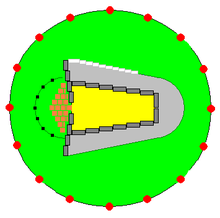Loughash
The Wedge Tomb of Loughash is a megalithic site in Northern Ireland . The complex that bears the name of the lake (Lough Ash) is located near the B48 (road) between Dunnamanagh and Plumbridge in County Tyrone , near the border with County Londonderry . Wedge Tombs ( German "Keilgräber" ), formerly also called "wedge-shaped gallery grave", are double-walled, aisle-free, mostly undivided megalithic systems from the late Neolithic and early Bronze Age .
description
Loughash has a trapezoidal cairn about 10 m long, 7.5 m wide at the front and 4.0 m wide at the back. The façade consists of two 1.4 m high stones, which together with the third, less than 50 cm high stone, form a kind of double portal. There is a single preserved lintel or capstone located in the front area of the chamber, which is set back about 1.7 m from the facade. The former chamber, which is open as a recess, is about 6.6 m long and 1.7 m wide. Many stones of the chamber wall and the outer masonry are in situ . The end of the cairn is rounded as usual with wedge tombs.
During the excavation, a broken heel ax was discovered near the facade and part of a bronze blade on the back. A small copper ring and the shards of four cups and five other pots were found along with flint fragments . Charcoal and burned bones, possibly from three people, were discovered at the back of the chamber.
The majority of the excavated wedge graves belong to the late Neolithic. Since many Stone Age facilities were reused during the Bronze Age , it is not uncommon for metal artifacts to be found during the excavation.
Cashelbane
In the district of Loughash, near Claudy, there is also the Wedge tomb of Cashelbane (Irish "Caiseal Bán", dt. "The white stone fort"). Cashelbane is lying in a large pile of stones. Three stones form a divided portal. The gallery is about 6.5 m long and 2.0 m wide. Only an area near the back wall is covered with a capstone. It measures approximately 2.0 m × 1.5 m. In the rear part the gallery is divided into two small chambers, which are formed by several transverse stones. Such a constellation can only be found in Ballyedmonduff in County Dublin in Ireland. The outer masonry is well preserved on both sides. The total size of the megalithic complex is 7.2 m in length and 3.5 m in width at the front, compared to 2.2 m in width at the rear. The cairn is low and about 19 m in diameter. It contains a large number of chunks of quartz . When the place was excavated in the 1930s, the cairn was over 55 meters in diameter and 1.5 meters above the capstone. The excavation yielded flint , lots of urns , burned bones and shards of vessels.
Another wedge tomb is 7.4 km away at Tireighter in Londonderry.
literature
- Kenneth McNally: Standing Stones and other monuments of early Ireland . Appletree, Belfast 1984, ISBN 0-86281-121-X .
- Oliver Davies, JB Mullin: Excavation of Cashelbane cairn, Loughash, Co. Tyrone. In: The Journal of the Royal Society of Antiquaries of Ireland. Vol. 10, No. 3, 1940, pp. 143-163, JSTOR 25510253 .
Web links
- Description and pictures (English)
- Cashelbane description and pictures (English)
- Description, location, pictures at: megalithic.co.uk
Coordinates: 54 ° 51 ′ 9.4 " N , 7 ° 14 ′ 50" W.


